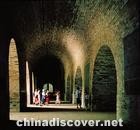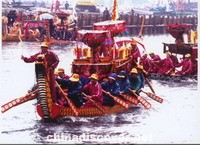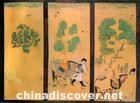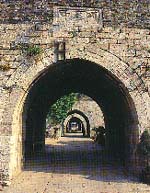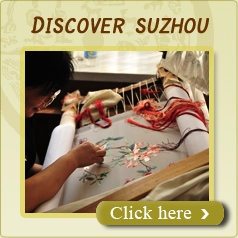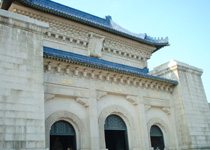Nanjing Ming Tombs
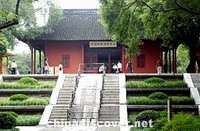
The Ming Xiaoling is the tomb of the founder of the Ming Dynasty, Zhu
Yuanzhang. He rose from poverty to lead a great army which pushed the
Mongols out of China in the 14th century. After victory, he established his capital at Nanjing. Something of a megalomaniac, he wanted a tomb complex grand enough to reflect his glory as the founder of a dynasty. Using feng-shui geomancy, his sages found the ideal location at the base of the Zijin Mountain in Nanjing.
The tomb complex, one of the largest in China, stretches over several dozen acres. It is made up of memorial temples, pavilions, grand gateways, and long avenues lined with stone statues, all laid out in the shape of the dipper constellation. The complex lies amidst gardens and the woods of the mountain, a calm natural setting which heightens the calm, historic atmosphere of the ancient statues and buildings.
The Ming Xiaoling Tomb in Nanjing is one of China's most important and
impressive historical sites, and its art, architecture, and grand scale have been drawing visitors for centuries. It recently received the honor of being listed as a UNESCO World Cultural Heritage site.
Perhaps the most famous section of the tomb is the long avenue of statues just past the massive entrance hall. Called a "Spirit Way" in traditional Chinese architecture, it was designed so the influence of the spirit of the buried emperor could still be felt in the world, and to provide a grand ceremonial approach to the tomb. Great plane trees arch over the stone flagged path, while a remarkable menagerie of Ming Dynasty stone animals line the path. They are arranged in pairs, one on each side of the path, facing each other. There are two pairs of each type of animal - one pair seated, and the other pair standing.
The life size stone statues show eight types of animals, ranging from lions and the mythical ki-rin unicorn to more modest horses and camels. Each animal was chosen for its symbolism - camels represented peace and trade with Central Asia, elephants majesty, and the mythical animals were allegories of the emperor's justice and virtue. The walkway is especially beautiful in the autumn, when the leaves of the arching trees turn golden yellow, and the ancient gray statues are dotted with fallen leaves.
After the avenue of the stone animals, the ceremonial road makes a sharp
turn - in Chinese mythology evil spirits could only travel in straight lines and a hairpin turn would keep them at bay! Giant statues of officials line this section of the tomb - some wear the robes of scholars, while others are clad in magnificent scale armor. They represented the civil and military officials that served the emperor. Overlooking the ceremonial avenues is the Plum Blossom Hill, topped by an elegant pavilion. Originally the burial mound of a warlord, it is now covered in hundreds of flowering plum trees. In late February and March and hill is coated in a thick blanket of white plum blossoms. Once the blossoms have fallen, tea buds are harvested from the bushes beneath, the leaves supposedly taking on the sweet scent of the flowering trees that surround them.
Past the ceremonial avenues, a wide stone road rises through the forest to the red walls that surround the main tomb complex. Inside the gates,
several courtyards of memorial halls, inscribed stelae, and elaborately
carved pavilions lead to the huge man-made hill that covers the emperor's tomb. The complex has a mysterious, rambling atmosphere - clusters of
ancient trees dot the grassy lawn, and small purple wildflowers poke through the ancient stones.
While many of the buildings are intact, others were reduced to ruins over the centuries, creating a mood of history and and the passage of time not found in other, over-restored monuments. Broken statues of coiled dragons lie amidst the grass, and ivy creeps over cloud-carved balustrades. At the far end of the complex, the forested tomb mound of the emperor rises behind a two story temple hall. According to legend the tomb contains fabulous treasures, along with the bodies of 27 imperial concubines who were buried alive to accompany their lord to the afterlife. (Source: jstour.com)
